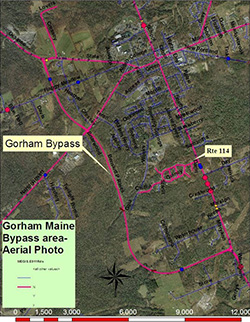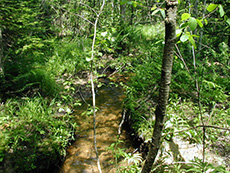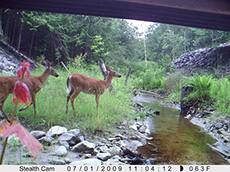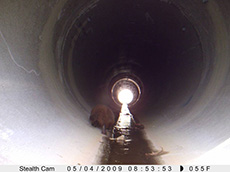Awards
Exemplary Ecosystem Initiatives — 2011
Maine: Gorham (Bernard P. Rines) Bypass Route 112 Wildlife Passage

Figure 1. Aerial photograph of Gorham, Maine, Bypass Area
Source: Maine Department of Transportation
The Gorham Bypass Route 112 Wildlife Passage supports wildlife crossings across a new bypass highway in Gorham, Maine. As a way to mitigate impacts from highway construction, the Maine Department of Transportation (MaineDOT), with assistance from the Federal Highway Administration, and U.S. Fish and Wildlife Service, established two bridges and additional culverts to support habitat connectivity in the affected areas.
MaineDOT and its partners carefully reviewed potential locations in selecting the appropriate placement of the Gorham wildlife passages. Areas with naturally-occurring incised topography and floodplains were chosen to ensure a smooth integration of the structures into the surrounding landscape. Adjacent topography and existing habitat were other key factors used to identify these sites.
MaineDOT also considered suitable openness ratios for the bridges and culverts in its research. As a result, the bridges maintain stream-side habitats and dense vegetation. The constructed culverts also have large openness ratios, which allow small animals to cross dry portions of the openings.
Since the establishment of the wildlife passages, still cameras have captured use of the structures by small and large wildlife, including white-tailed deer and turkey. Animal-vehicle collisions have continued to occur on other nearby roads, including roads that cross the same habitat blocks. However, only one animal-vehicle collision has been reported in the project area since construction of the wildlife passages, an indicator of the project's success in providing alternate crossings for animals.
MaineDOT received design and strategic support from other State and Canadian provincial departments of transportation and contacts from the 2004 and 2006 Northeastern Transportation and Wildlife Conference (NETWC) in designing and planning the wildlife crossing structures along Gorham Bypass. The department is now giving back to its supporters by furthering knowledge of habitat connectivity methods. MaineDOT has presented this project at the 2006, 2008, and 2010 NETWCs and continues to contribute to the growing body of literature and research on wildlife passages.
For more information, contact Richard Bostwick, Maine Department of Transportation, at richard.bostwick@maine.gov.

Figure 2. Big Gully Brook prior to the Gohram Bypass project
Source: Maine Department of Transportation
|

Figure 3. Deer often frequent the completed wildlife passage
Source: Maine Department of Transportation
|

Figure 4. Culverts, like the one by Flagg Meadow Road (shown here), support wildlife crossings for smaller animals. Here, a beaver uses this culvert for passage.
Source: Maine Department of Transportation
|

